Car owners take great pride in maintaining the appearance of their vehicles, but sometimes an unexpected enemy can wreak havoc on their prized possession - acid. In this article, we will explore the various types of acid that can destroy car paint, their sources, and provide practical tips on how to prevent and mitigate the damage.
- Acid Rain: A Silent Paint Destroyer
Acid rain, a phenomenon caused by air pollution, poses a significant threat to car paint. When pollutants such as sulfur dioxide and nitrogen oxide mix with moisture in the atmosphere, they form sulfuric and nitric acid, which can fall as rain. These acids have a corrosive effect on car paint, gradually eating away at its protective layers. - Bird Droppings: More than Just a Nuisance
While bird droppings may seem harmless, they contain uric acid, which can be highly damaging to car paint. Uric acid has a strong corrosive nature and can penetrate the paint's surface, causing discoloration and etching. Prompt removal of bird droppings is crucial to prevent long-term damage. - Tree Sap: A Sticky Situation
Tree sap, a natural resin produced by trees, can also wreak havoc on car paint. The sap contains organic acids that can chemically react with the paint, leading to stains and even paint degradation. It is important to remove tree sap promptly and avoid parking under trees for extended periods. - Industrial Fallout: A Hidden Threat
Industrial fallout refers to the deposition of pollutants emitted by factories and industrial processes onto car surfaces. These pollutants, including sulfur compounds, heavy metals, and other acidic substances, can gradually corrode car paint if left untreated. Regular washing and waxing can help remove and protect against industrial fallout. - Road Salt: Winter's Paint Nemesis
During winter, road salt is commonly used to melt ice and snow on roads. However, the salt can also cause significant damage to car paint. Salt contains chloride ions, which accelerate the corrosion process. Regular car washes, especially in winter, are essential to remove salt deposits and protect the paint.
Prevention and Mitigation:
- Regularly wash and wax your car to create a protective barrier against acid attacks.
- Park your car in a covered or sheltered area to minimize exposure to acid rain, bird droppings, and tree sap.
- Promptly remove bird droppings, tree sap, and other contaminants to prevent long-term damage.
- Apply a paint sealant or ceramic coating for added protection against acid attacks.
- Consider using car covers or paint protection films to shield your vehicle from environmental hazards.
Conclusion:
Protecting your car's paint from acid damage requires awareness, preventive measures, and prompt action. By understanding the various sources of acid that can destroy car paint and implementing the suggested preventive measures, you can maintain the pristine appearance of your vehicle for years to come. Remember, a little extra care today can save you from costly paint repairs in the future.

